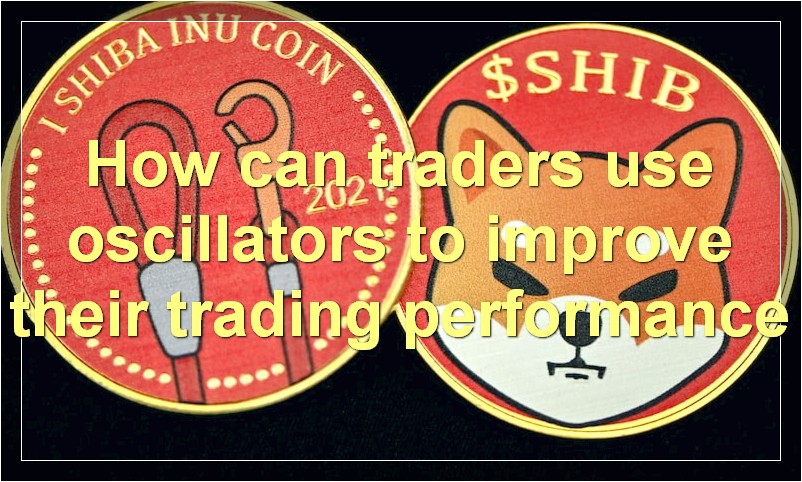If you’re looking to up your trading game, oscillators are a great tool to add to your arsenal. In this article, we’ll tell you everything you need to know about oscillators and how to use them to improve your results.
How does an oscillator work in trading
An oscillator is a technical analysis tool that is used to gauge the strength or momentum of a security’s price. Technical analysts use oscillators to help identify market conditions, such as overbought or oversold levels.
Oscillators are calculated using a security’s price action, which is the change in price over time. The most common oscillators are based on the security’s closing price, but some use other data points, such as the high, low, or open prices.
The two most popular oscillators are the Relative Strength Index (RSI) and the Stochastic Oscillator. Both indicators are used to signal when a security is overbought or oversold.
The RSI measures the ratio of up days to down days, and it is plotted on a scale of 0 to 100. A reading above 70 indicates that a security is overbought, while a reading below 30 indicates that it is oversold.
The Stochastic Oscillator is similar to the RSI, but it uses different data points, such as the high and low prices instead of the close price. The Stochastic Oscillator is plotted on a scale of 0 to 100, with readings above 80 indicating that a security is overbought, and readings below 20 indicating that it is oversold.
What are the most popular oscillators used in trading

There are many different oscillators used in trading, but some of the most popular ones are the Relative Strength Index (RSI), the Stochastic Oscillator, and the MACD. Each of these oscillators has its own strengths and weaknesses, so it’s important to choose the one that best suits your trading style.
The RSI is a momentum indicator that measures whether a stock is overbought or oversold. It is a popular oscillator because it is relatively easy to interpret and can be used to generate buy and sell signals.
The Stochastic Oscillator is another momentum indicator that is often used by traders. It measures the level of a stock’s recent price changes relative to its overall price range. Like the RSI, the Stochastic Oscillator can be used to generate buy and sell signals.
The MACD is a trend-following indicator that measures the difference between two moving averages. It is a popular oscillator because it can be used to identify both trend reversals and continuation patterns.
How do traders use oscillators to trade the markets
Oscillators are a type of technical indicator that are used by traders to help identify overbought and oversold conditions in the market, as well as potential reversals. They are typically plotted as a line on a price chart and oscillate between two extremes. The most popular oscillators include the Relative Strength Index (RSI), Stochastic Oscillator, and MACD.
Traders will often use oscillators in conjunction with other technical indicators or chart patterns to confirm trading signals. For example, if an oscillator is showing overbought conditions and price action is starting to stall at a resistance level, this could be indicative of a potential reversal. Similarly, if an oscillator is showing oversold conditions and price action is starting to rebound off a support level, this could be indicative of a potential bullish reversal.
Oscillators can also be used to identify divergence which can be used as an early warning sign for potential trend reversals. Divergence occurs when the oscillator is moving in the opposite direction of price action. For example, if price action is making new highs but the oscillator is failing to do so, this could be bearish divergence and indicative of a potential top. Conversely, if price action is making new lows but the oscillator is failing to do so, this could be bullish divergence and indicative of a potential bottom.
What are the benefits of using an oscillator in trading
An oscillator is a technical analysis tool that is used to gauge the strength or momentum of a security’s price movement. Oscillators can be used to identify overbought or oversold conditions, as well as potential reversals. There are many different types of oscillators, each with its own strengths and weaknesses. Some common oscillators include the Relative Strength Index (RSI), Stochastic Oscillator, and MACD.
Oscillators can be very helpful in trading, as they can provide valuable insights into a security’s price movement. Overbought and oversold conditions are often leading indicators of potential reversals, so by using an oscillator, traders can get ahead of the crowd and position themselves for potential profits.
What are the risks of using an oscillator in trading
When trading, there are a variety of risks that come with using an oscillator. One such risk is that the indicator may give false signals. This means that the trader may enter or exit a trade based on a signal that ends up being incorrect. Another risk is that the oscillator may not be well suited for the particular market conditions that are being traded. This could lead to the trader making sub-optimal decisions based on the signals that are being generated. Finally, even if the oscillator is well suited for the market conditions and is accurate, the trader still needs to be able to interpret the signals correctly in order to make profitable trades.
How can traders use oscillators to improve their trading performance

Oscillators are technical indicators that are used to measure momentum. They can be used to identify overbought and oversold conditions, and to time the market.
There are many different oscillators available, each with its own strengths and weaknesses. The most popular oscillators include the Relative Strength Index (RSI), the Stochastic Oscillator, and the MACD.
Traders can use oscillators to help them make better trading decisions. For example, if an oscillator is showing that a market is overbought, traders might look to sell. Or, if an oscillator is showing that a market is oversold, traders might look to buy.
Oscillators can also be used to time the market. For example, if an oscillator is showing that a market is about to turn, traders might look to enter or exit a position.
While oscillators can be helpful, it’s important to remember that they are just one tool in a trader’s toolbox. Oscillators should not be used in isolation, but rather in conjunction with other technical indicators and fundamental analysis.
What are some common mistakes that traders make when using oscillators
Some common mistakes that traders make when using oscillators are failing to properly calibrate the indicator, not accounting for the underlying asset’s price action, and using an oscillator for trend following instead of trend confirmation.
One mistake that traders often make when using oscillators is failing to properly calibrate the indicator. Oscillators are technical indicators that are used to measure momentum, and they are typically calibrated using a 14-period moving average. However, if the trader does not properly calibrate the indicator, it can lead to false signals.
Another mistake that traders make is not accounting for the underlying asset’s price action. When using oscillators, it’s important to consider the price action of the underlying asset in order to avoid false signals. For example, if an oscillator is indicating that a stock is overbought but the stock’s price is still trending higher, it’s likely that the stock isn’t actually overbought and the signal is false.
Finally, some traders use oscillators for trend following instead of trend confirmation. Oscillators are best used as a tool to confirm trends, not to initiate them. This is because oscillators can often give false signals in choppy or range-bound markets. If a trader is looking to initiate a trade based on an oscillator signal, they should make sure that the market is in a clear trend before entering.
How can traders avoid making mistakes when using oscillators
When using oscillators, traders should be aware of a few potential pitfalls that could lead to inaccurate readings and costly mistakes. First, many oscillators are based on historical data and can therefore be lagging indicators. This means that they might not pick up on current trends until after they’ve already begun, which could cause traders to enter into losing positions. Second, different oscillators can often give conflicting signals, so it’s important to use more than one and take them all into account when making trading decisions. Finally, it’s important to remember that oscillators are just one tool in a trader’s toolbox and shouldn’t be relied on exclusively. By being aware of these potential dangers and using oscillators in conjunction with other technical indicators, traders can avoid making costly mistakes.
What are some advanced techniques for using oscillators in trading
Some advanced techniques for using oscillators in trading are to use them as a leading indicator, to trade with the trend, and to use them in conjunction with other technical indicators. Oscillators can be used to identify overbought and oversold conditions, to spot divergences, and to generate buy and sell signals. When used correctly, oscillators can be a valuable tool for traders.
Can oscillators be used in conjunction with other technical indicators to improve trading results
Oscillators are a type of technical indicator that can be used by traders to help identify potential trading opportunities. When used in conjunction with other technical indicators, oscillators can help to improve the accuracy of trading signals and potentially improve trading results.

